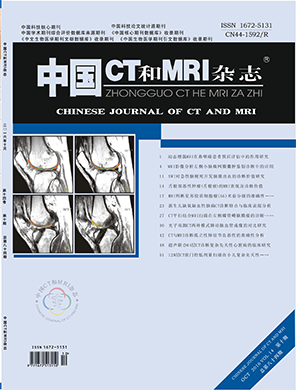摘要
目的 探讨并对比超声造影、 CT、MRI在卵巢肿瘤诊断中的应用价值。 方法 回顾性分析63例经临床病理确诊的 卵巢肿瘤患者的超声造影、CT及MRI影像 资料,并与病理学结果对比。结果 MRI诊 断符合率、敏感性、特异性略高于超声造 影检查,但组间比较无差异(P>0.05); CT诊断准确率低于MRI、CT(P<0.05)。超 声造影上,良性肿瘤实性成分为主表现为 从瘤体周边向内部灌注,囊性成分为主可 见囊壁呈环状不均匀增厚。恶性肿瘤实性 成分为主组织有不同程度的增强,多数肿 瘤体内部向周边病灶强化;囊性成分为主 组织囊壁及囊内分隔明显增强。CT表现 上,良性肿瘤以囊性多见,增强扫描无明 显强化;恶性肿瘤有“分叶征”,或多房 性;以实性成分为主增强扫描后呈均匀或 不均匀强化,囊性成分肿块增强扫描后无 明显强化。MRI表现上,良性肿瘤囊性成 分为主组织信号复杂,增强扫描囊壁及间 隔有轻、重度强化;实性成分组织为主可 见MRI信号不规则,增强扫描后实性部分 为延迟不均匀强化。恶性肿瘤以囊实性病 灶或实性病灶为主,囊实性部分为T1WI低 信号,T2WI高信号,囊壁多呈结节或乳头 状从囊内突出囊外;实性部分T1WI等或低 或混杂信号,T2WI高信号,增强扫描中重 度明显强化。实性肿块信号不均匀,增强 扫描后信号不均,部分见腹水、淋巴结转 移或盆腔受侵。
Objective To investigate and compare contrast-enhanced ultrasound, CT and MRI in the diagnosis of ovarian tumors. Methods Retrospective analysis 63 cases of patients with the clinical pathological diagnosis of ovarian tumors contrast-enhanced ultrasound, CT and MRI image data, and compared with pathology results. Results MRI diagnosis coincidence rate, sensitivity, specificity, slightly higher than the contrastenhanced ultrasound examination, but is no difference between groups (P>0.05). The CT diagnostic accuracy is lower than the MRI, CT (P<0.05). Contrast-enhanced ultrasound, benign tumor or solid composition mainly show is from the surrounding the tumors had to internal perfusion, cystic components mainly visible capsule wall show cricoid uneven thickening. Malignant solid composition is mainly organization have different degrees of enhancement, most of the tumor inside the body to the peripheral lesion enhancement. Cystic components mainly organization within the capsule wall and separated. On CT manifestations, benign tumors with cystic, enhanced scan without obvious strengthening. Malignant tumors have Ye Zheng "points", or multilocular; Give priority to with solid composition is uniform or non-uniform strengthen after enhancement scanning, a cystic component mass no obvious reinforcement after enhanced scanning. MRI performance, benign cystic components is given priority to organize complex signal, cystic wall enhancement scanning interval reinforced with light and heavy. Solid component organization mainly visible MRI signal is irregular, solid part is the uneven delay after enhancement scanning reinforcement. Malignant tumor is given priority to with capsule real STD focal or real STD focal, pouch or solid tumor, solid cystic component for T1WI low signal, high T2WI signal, the capsule wall formed a nodule or papillary outside protruding out of the sac sac. Solid part of T1WI low or mixed signal, high T2WI signal, enhanced scan be excessie significantly improved. Solid tumor signal is uneven, uneven enhancement scan signal, some see ascites had invasion, lymph node metastasis or pelvic cavity. Conclusion contrast-enhanced ultrasonography is the first choice for differential diagnosis of benign and malignant ovarian tumor imaging.
【关键词】卵巢肿瘤;超声肿瘤;磁共振 成像;断层摄影技术
【中图分类号】R737.31
【文献标识码】A
【DOI】 10.3969/j.issn.1672- 5131.2016.10.030
前言
卵巢肿瘤是女性常见的生殖器官肿瘤之一,卵巢肿瘤组织来源复 杂、种类较多,其中卵巢恶性肿瘤位居妇科恶性肿瘤的第三位。研究 报道,FIGO I~Ⅱa期卵巢术后5年生存率较高[1]。因卵巢位置较深, 且发病初期无特异性症状,部分卵巢癌患者入院时已处于疾病中晚 期,5年生存率较低。因此,提高对卵巢肿瘤良恶性鉴别诊断率,便于 指导临床确诊治疗方案,早期给予针对性治疗,降低疾病死亡率。超 声造影、CT、MRI是临床诊断卵巢肿瘤较为常用的影像学方式,各有其 优势,但临床鲜少关于超声造影、CT、MRI诊断卵巢肿瘤的对比研究报 道。对此,本文分析了超声造影、CT、MRI在鉴别诊断良恶性卵巢肿瘤 的准确性及影像学表现,现报道如下。
中国CT和MRI杂志
第14卷, 第 10 期
2016年10月

相关文章